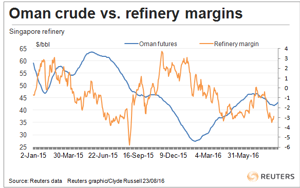Column: China's fuel exports less worrisome than crude costs for refiners
(Clyde Russell is a columnist for Reuters. The opinions expressed are his own.)
(Reuters) A surge in China's diesel exports last month to record levels is probably the last thing refiners in the rest of Asia wanted to hear, but they should probably worry more about rising crude oil prices.
While China's booming fuel exports appears to have contributed to a structural lowering of profit margins for the region's refiners, the ups and downs still seem to be largely inversely linked to movements in crude prices.
China exported 1.53 M tons of diesel in July, equivalent to about 370 Mbpd and 181.8% higher than the same month a year earlier, according to customs data.
Diesel exports were almost triple the monthly average from 2015, as China's major refiners were forced to look to overseas buyers amid growing competition from small refiners and soft demand growth in the domestic economy.
It's not just diesel exports that are booming, with gasoline shipments up 145% in July from the same month last year to 970,000 tons, equivalent to about 266 Mbpd.
While this was slightly down from the June record of 1.1 M tons, exports in July were still almost double the monthly average for the whole of 2015.
Exports of kerosene, a middle distillate used mainly as jet fuel in Asia, are also up strongly, with July's 1.09 M tons (274 Mbpd) being 46% higher year on year.
What rising fuel exports from China appear to have done so far in 2016 is lower refining margins in a structural sense.
For example, the premium of gasoil, the broad term for middle distillates that include diesel, in Singapore over Dubai crude averaged $11.26/bbl in 2015, but so far this year it is $10.29.bbl, a reduction of almost 10%.
The drop is starker in gasoline, where the Singapore margin over Brent crude has dropped from an average of $15.08/bbl in 2015 to just $4.89/bbl so far this year.
While Chinese exports can't be fully blamed for the shrinking margins, they have no doubt contributed by adding to the amount of refined products seeking a home in Asia.
Refinery profits linked to crude. Overall refining margins have also slumped this year, according to data compiled by Thomson Reuters.
The profit of processing a barrel of Dubai crude at a refinery in Singapore was $4.28/bbl in early trade on Tuesday, down from the peak of $9.96/bbl in January this year and also below the moving 365-day average of $6.53/bbl.
Another measure of profits for a Singapore refinery processing Dubai crude, which takes into account freight costs and a typical product slate, shows a gross refining margin of a loss of $2.87/bbl currently, down from the recent monthly high of $2.19/bbl profit in January.
It's also clear that the refinery margins are more responsive to moves in the price of crude.
This year, the refinery margin was at its highest in January, just at the time that Oman crude futures were at their lowest.
As the price of the main crude future for Asia has recovered, so the refinery margins have deteriorated.
This pattern has held true since Oman futures started trading last decade, notwithstanding what appears to be a structural move lower in refinery margins in the past year as Chinese fuel exports have ramped up.
This would imply that Asian refiners have two things to deal with in the current market situation.
The first is that the rise of China as a force in product markets has cut profitability for the region's refiners, a dynamic likely to continue until Chinese domestic demand improves enough to soak up surplus refinery output.
The second is that the inverse relationship between crude prices and refinery margins remains intact, meaning that the short-term outlook for profits is more likely tied to whether crude prices continue their recent rally, or whether the global overhang of crude drags the price down again.
Global oil prices surged 20% from the start of the month to their peak on Friday, but have eased about 5% since then amid worries the rally had been overdone and that a proposed oil production freeze at current near-record levels would not help rein in an oversupplied market.
By Clyde Russell; Editing by Himani Sarkar







Comments